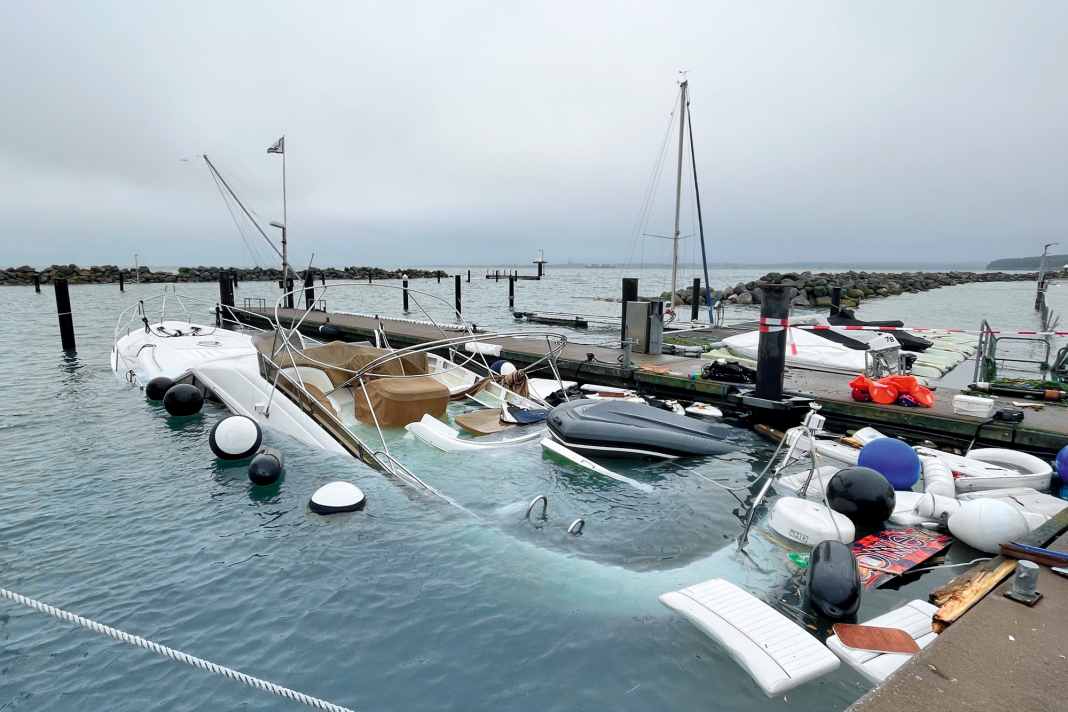



In the night from 20 to 21 October 2023, low pressure system "Wolfgang" caused the worst Baltic storm surge since 1872 due to strong, persistent easterly winds on the Baltic Sea coast of Schleswig-Holstein and Denmark. Water levels of well over two metres above normal led to some dramatic scenes in the towns and municipalities bordering the coast on the Schleswig-Holstein Baltic Sea coast. In addition to the residents of the affected regions, the owners of the ships moored in the various marinas were particularly affected by the storm floods. Over 60 yachts sank in Kiel and Damp alone. Hundreds more were damaged, some irreparably. The storm surge also caused severe damage to the infrastructure of the affected harbours.
The clean-up work is now in full swing. The marinas need to be overhauled for the upcoming 2024 season. The damaged yachts must be salvaged, assessed and - where possible - repaired. The insurers, who are usually already involved in the damage assessment, have a busy turn of the year ahead of them. The northern German repair yards can look forward to full order books.
But who pays for the damage? Under what conditions can owners make a claim against their insurers? Under what conditions can they refuse cover? What does the hull insurer have to pay and what does the liability insurer have to pay? Can certain behaviour on the part of the policyholder jeopardise cover?
The comprehensive cover
German yacht hull insurance conditions are generally structured as so-called all-risk cover. As part of all-risk cover, an insurer undertakes to compensate for all damage occurring to the insured object, unless the cause of damage is explicitly excluded in the insurance conditions. In principle, damage caused by a storm is not covered by the exclusion clauses of the insurance conditions. Damage to a yacht caused by a storm is therefore generally insured. The situation is different if the policyholder has breached contractual insurance obligations. First and foremost, this includes failure to take measures to minimise damage. If the policyholder is aware, or as a result of gross negligence is not aware, that it is almost certain that damage will occur, he is obliged to take all possible and necessary measures to avert the damage.
The Federal Maritime and Hydrographic Agency (BSH) had already warned of the storm surge a few days before 21 October 2023. Accordingly, insurers could argue that protective measures should have been taken by the respective yacht owner as far as possible. This does not only apply if it subsequently transpires that the damage in question only occurred or only occurred to this extent because the vessel in question was not properly moored or secured. This could also be argued if a yacht owner, knowing that damage was imminent, did not remove valuables such as watches, jewellery or art from the vessel.
Long-announced extreme weather events can therefore lead to a reduction in cover corresponding to fault, at least if safety measures are deliberately or grossly negligently not taken.
What exactly does the yacht hull insurer have to pay?
If there is no breach of obligation, damage to the ship as a result of extreme weather events, including the Baltic storm flood of 2023, is covered. Another question is what exactly the yacht hull insurer has to pay. This depends - who would be surprised - on the agreed terms of the policy. It is conceivable that in the event of a total loss, the insurer will have to pay the value of the ship or a fixed agreed rate, for example the new value of the ship.
Whether he also has to compensate for other damage also depends on the conditions of the respective insurance contract. This is particularly interesting with regard to salvage and wreck removal costs. Depending on the wording of the insurance contract, it could be argued that salvage costs are only included in the insurance cover if the salvaged yacht can be repaired. If this is not the case for economic reasons - keyword: total economic loss - the object to be salvaged is no longer a ship, but a wreck. However, unlike the salvage of a ship, the salvage of a wreck is excluded in a large number of yacht insurance conditions. The same applies to the costs of disposing of the wreck. These costs are also typically not included in the scope of cover of yacht hull insurance.
Liability cover
In addition to hull insurance, yacht owners should also keep an eye on their liability insurance policy. This is because it provides cover for third-party claims under private law against the policyholder. So if the yacht has caused damage to a third party, for example the marina or the neighbouring ship, due to the insured event "storm", and the policyholder is held liable for damages by the marina or the neighbouring yacht, this may be an insured liability claim.
In this context, it is important to know that liability insurance may not only take effect when the damage has occurred, but also when the damage is imminent. This is because not only the policyholder but also the liability insurer has an interest in minimising damage. They therefore also take action when damage is imminent. In addition, most liability insurance policies contain clauses relating to water pollution. So if a sunken yacht is in danger of leaking fuel (oil and/or bunker), it can be argued that the salvage of the yacht - as a loss minimisation measure - is covered by liability insurance and can be initiated before major damage occurs.
Speaking of the obligation to minimise damage: This obligation exists for policyholders in principle and in relation to all insurance policies. The policyholder is therefore always obliged to minimise the damage for the insurance company as far as possible. In the context of storm damage and the salvage and disposal of wrecks, this means that the owner may be obliged to sell the wreck at the highest possible price. Even if the residual value is minimal, the insurer has saved the disposal costs, if covered.
Experts for all questions relating to yacht law

The yacht lawyers Dr Tim Schommer (tim.schommer@clydeco.com) and Dr Volker Lücke (volker.luecke@clydeco.com) have been advising yacht clients from Germany and abroad for over 18 years. They advise on the planning and construction phase, the purchase and sale, the owner structure, yacht operation including insurance, crewing and charter as well as the handling of damage and third-party claims.

